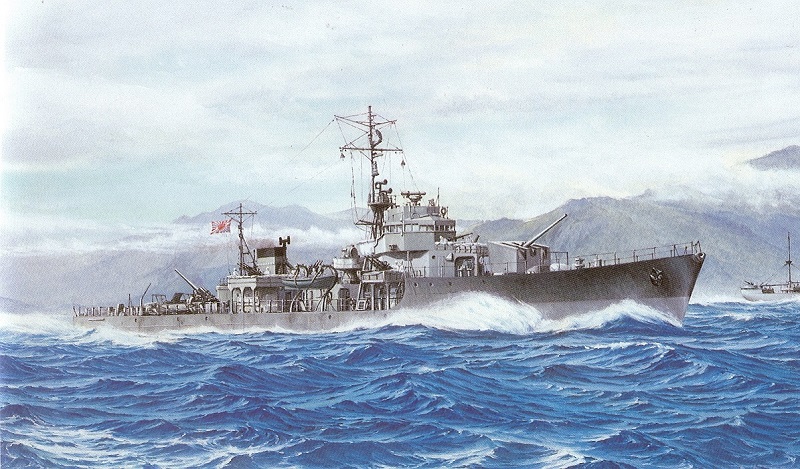© 2009 Bob Hackett and Peter Cundall
5 December 1944:
Osaka. Laid down at Naniwa Dock Co., Ltd.
10 February 1945:
Launched and numbered CD-227.
15 June 1945:
Completed.
15 August 1945:
Japan accepts the Allies “Potsdam Declaration” (of unconditional surrender) and hostilities cease.
5 October 1945:
Removed from the Navy List.
20 October 1945:
Departs Sasebo on her first repatriation voyage.
27 October 1945:
Arrives at Tacloban. Embarks troops and passengers to be repatriated.
28 October 1945:
Departs Tacloban.
29 October 1945:
Arrives at Davao. Embarks troops and passengers to be repatriated.
31 October 1945:
Departs Davao.
12 November 1945:
Arrives at Kagoshima. Disembarks troops and passengers.
19 November 1945:
Enters dockyard at Mukaijima for repairs.
23 November 1945:
Repairs are completed.
1 December 1945:
Officially assigned to the Allied Repatriation
Service. [1]
6 December 1945:
Departs Kure.
14 December 1945:
Arrives at Tacloban and departs later that day.
22 December 1945:
Arrives at Pusan and departs later that day.
23 December 1945:
Arrives at Hakata. Disembarks troops and passengers.
29 December 1945:
Enters dockyard at Kure for repairs.
31 January 1946:
Repairs completed.
3 February 1946:
Departs Kure.
5 February 1946:
Arrives at Korojima near Tsientsin. Embarks troops and passengers to be repatriated.
6 February 1946:
Departs Korojima.
8 February 1946:
Arrives at Shanghai. Embarks troops and passengers to be repatriated.
10 February 1946:
Departs Shanghai.
12 February 1946:
Arrives at Hakata. Disembarks troops and passengers.
14 February 1946:
Departs Hakata.
16 February 1946:
Arrives at Shanghai. Embarks troops and passengers to be repatriated.
17 February 1946:
Departs Shanghai.
20 February 1946:
Arrives at Hakata. Disembarks troops and passengers.
22 February 1946:
Departs Hakata.
24 February 1946:
Arrives at Shanghai and departs later that day.
26 February 1946:
Arrives at Hakata. Disembarks troops and passengers.
5 March 1946:
Enters dockyard at Kure for repairs.
25 March 1946:
Repairs are completed.
31 March 1946:
Departs Hakata.
3 April 1946:
Arrives at Shanghai. Embarks troops and passengers to be repatriated and departs later that day.
5 April 1946:
Arrives at Hakata. Disembarks troops and passengers.
8 April 1946:
Departs Hakata.
9 April 1946:
Arrives at Pusan. Embarks troops and passengers to be repatriated and departs later that day.
11 April 1946:
Arrives at Shanghai. Embarks troops and passengers to be repatriated.
16 April 1946:
Departs Shanghai.
20 April 1946:
Arrives at Hakata.
28 April 1946:
Departs Hakata. Disembarks troops and passengers.
1 May 1946:
Arrives at Korojima near Tsientsin. Embarks troops and passengers to be repatriated.
10 May 1946:
Departs Korojima.
13 May 1946:
Arrives at Hakata. Disembarks troops and passengers.
18 May 1946:
Departs Hakata.
21 May 1946:
Arrives at Korojima. Embarks troops and passengers to be repatriated.
23 May 1946:
Departs Korojima.
26 May 1946:
Arrives at Hakata. Disembarks troops and passengers.
31 May 1946:
Departs Hakata.
3 June 1946:
Arrives at Korojima. Embarks troops and passengers to be repatriated.
4 June 1946:
Departs Korojima.
7 June 1946:
Arrives at Hakata. Disembarks troops and passengers.
13 June 1946:
Departs Hakata.
16 June 1946:
Arrives at Korojima. Embarks troops and passengers to be repatriated.
17 June 1946:
Departs Korojima.
20 June 1946:
Arrives at Hakata. Disembarks troops and passengers.
18 June 1947:
Dai-ichi Building, Tokyo. Japanese warships are to be divided into four roughly equal lots among the "Big Four" victorious nations (i.e. U.S., U.K., USSR, China). Vice Admiral Robert M. Griffin, commander of U.S. Naval Forces, Far East, conducts the first drawing of lots that includes a total of 24 destroyers and 68 kaibokan. The Soviet Union is allotted 34 former IJN warships, including 7 destroyers and 17 escort vessels.
28 August 1947:
Nakhodka Bay, Siberia, Maritime Province. CH-227 is ceded to the Soviet Navy as a war reparation.
Late October 1947:
Transferred to Vladivostok.
Authors' Notes:
[1] Allied occupation forces were responsible for the return of six million Japanese military personnel and civilians from Japan's defunct far-flung Empire. In addition, there were over a million Korean and about 40,000 Chinese prisoners and conscript laborers and approximately 7,000 Formosans and 15,000 Ryukyu Islanders to be repatriated.
Some Allied and many former IJN warships, from aircraft carriers to kaibokan, were used to facilitate the enormous repatriation effort. Japanese vessels and crews were used to the fullest extent possible to conserve Allied manpower and accelerate demobilization. Each ex-IJN ship first had to be demilitarized; guns removed or, in the case of large warships, barrels severed, ammunition landed, and radar and catapults removed, if fitted. Repatriation of the Chinese on Japanese ships began early in October from Hakata, but U.S. guard detachments had to be placed on many ships to prevent disorder because the Japanese crews could not control the returnees.
Japanese-run repatriation centers were established at Kagoshima, Hario near Sasebo, and Hakata near Fukuoka. Other reception centers were established and operated at Maizuru, Shimonoseki, Sasebo, Senzaki, Kure, Uraga, Yokohama, Moji and Hakodate. Allied line and medical personnel supervised the centers. Incoming Japanese were sprayed with DDT, examined and inoculated for typhus and smallpox, provided with food, and transported to his final destination in Japan.
-Bob Hackett and Peter Cundall
Back to
Escort Page



